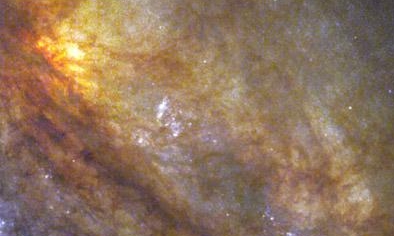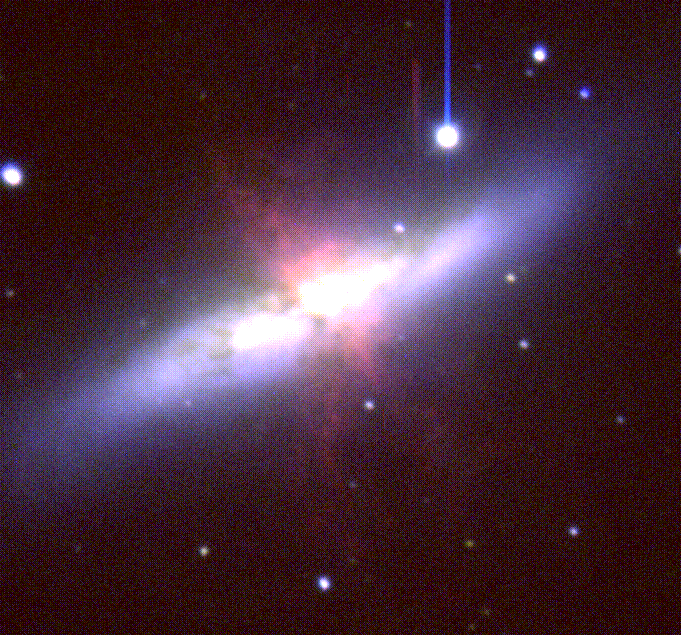Some galaxies, or their nuclei, show evidence of a recent and
transient increase in SFR by as much as a factor of 50. Symptoms of
this may be
unusually strong radio continuum emission
The burst may be galaxy-wide or confined to a small region about the
nucleus (few hundred parsec scales). Many (but by no means all)
are associated with
interacting or merging galaxies. Starbursts are strongly represented
in flux-limited samples of UV-bright galaxies (the Markarian catalog)
or IR-bright systems. Their optical spectra resembly those of H II
regions, with a blue stellar continuum and strong line emission, as
seen in the integrated spectrum of the prototype NGC 7714 from the
Kennicutt spectral atlas:

The role of reddening and obscuration in starbursts is complex, and
makes detailed interpretation of their continuum and emission-line
properties complicated. Calzetti et al. (1994 ApJ 429, 582) derived an
effective reddening law,
including effects of scattering and the mix of stars and dust, which
changes systematically depending on the metallicity of the system
and the far-IR fraction. There is evidence that the reddening of
the gas and stars is systematically different, perhaps due to dust
associated specifically with the gas emission regions, and there
is different weighting of gas along the line of sight for
different lines, reflecting density and reddening structure.
Much of the star formation in starburst systems has been found to occur
in very luminous, compact star clusters (up to 108 solar luminosities,
dimensions of a few parsecs), which occur in bursting
dwarfs, interacting galaxies, and mergers; 30 Doradus in the LMC
may also be of this type. Some are apparent in this HST UV
image of Markarian 357:

Interest in these clusters is strong for
several reasons. The Milky Way is not obviously forming stars in this
way now, so they may represent a distinct mode of star formation different
from the processes we are familiar with in our own neighborhood.
If these objects have a "normal" initial mass function and remain
gravitationally bound after the mass loss from massive members is complete,
they will eventually look a great deal like globular clusters (which the
Milky Way doesn't make anymore either). These clusters are the most
dense and intense star-forming environments known, and may be
analogs of typical objects in the early epochs of galaxy formation.
They come as bright as MV=-15 (the nucleus of
NGC 4569
may have gotten above -19 in its younger days), with characteristic
sizes of a few parsecs.
One is often tempted to take giant H II regions as models
of starbursts, though the higher gas density in nuclei and increased
role for obscuration when so much local material exists will make
for differences. Even so, we see nearby luminous H II regions
with (30 Doradus) and without (NGC 604) dominant dense star clusters.
Starburst mechanisms: Much of the interest in starburst
galaxies has been brought on by wondering how some galaxies, and often
very small regions in their nuclei, manage to convert so much gas
effectively into stars in a very short time. Often there's plenty of
molecular gas as judged from CO emission, so it's not a fuelling
question so much as a collection puzzle. How can so much molecular
gas collect without already forning stars on the way (the analogous
issue for fissile material is known as the "fizzle problem").
The statistics
of starbursts may hold a clue - starbursts are notably more common
in interacting and merging systems than in more isolated galaxies.
While this does not mean that more of them occur in interactions
(simply because only about 10% of galaxies are in bound pairs),
it does suggest that the conditions are far easier to attain during
interactions and mergers. A number of indicators of star formation
tell similar stories here. The majority of spirals in pairs experience
an increase in SFR typically 30%, while a few experience increases of an
order of magnitude. The burst is often confined to a few hundred
parsecs near the nucleus, although disk-wide bursts are common.
This preference for disturbed galaxies has led to a range of speculations on
what causes the enhancements (and thus at least contributes to starbursts).
Direct impact of gas-rich dwarf satellites into disks:
This is a large-scale variant of the picture of cloud collisions
between two galaxies. In this case, the obvious interaction with
a bright companion is not the one causing the fireworks. Statistics of
faint companions are not yet well enough determined to tell how important
this process might be.
From general considerations, some of the induced star formation must be
triggered by processes not requiring direct contact of disk material from
different galaxies; some objects with high SFR are too far apart, and
relatively undisturbed, so that internal effects of tidal stress must be
responsible.
Detailed modelling is thwarted by the great range of relevant physical
scales in some of these cases. In testing these proposals, studies of the
ISM in interacting systems, and understanding their dynamics, are crucial.
For example, H2 masses in combination with SFR estimates can suggest
whether the SFR goes up because of creation or accumulation of new
molecular gas (and normal accompanying star formation), or via an
enhancement of the "efficiency" of star formation. A survey of 13 merger
candidates by Young et al. (1986 ApJL 311, L17) suggested that the SFR
reflects large
molecular gas content; more recent results (Young, IAU Symp. 146)
extend this by suggesting that the H2/H I mass ratio is systematically
larger in interacting systems than in normal spirals. CO surveys of
complete and well-understood sets of both interacting and non-interacting
galaxies are urgently needed (and in progress).
For very luminous galaxies which are dusty enough that most of
their power emerges in the far-IR (once known as IRAS galaxies, now
sharing such acronyms as LIRG, ULIRGs, PIGs, or ELFs), it can be subtle to tell
whether the dominant energy source is a starburst or AGN. Compact, flat-spectrum
radio sources indicate an AGN, but more diffuse radio emission can come
from star-forming nuclei as well. Condon and Broderick
(1988 AJ 96, 30) have introduced a ratio of
radio and far-IR flux densities as a discriminant, based on the empirical
relation found for star-forming regions and the fact that powerful AGN
are usually more radio-loud. Mid-IR spectra have proven to be very useful,
since these photons emerge through the surrounding dust. High-ionization
species indicate an AGN, while their lack and strong PAH features
(destroyed by the intense hard radiation from an AGN) suggest a starburst.
Laurent et al. (2000 A&A 359, 887) find that while the "unidentified"
PAH band at 6.2 microns occurs only in starbursts, there is dust
continuum emission from 3-10 microns which is characteristic only
ofthe very hot region around an AGN.
Of course, a relatively unobscured nucleus can be classified from its
optical spectrum. Some nuclei of both flavors are so dusty that opacity
effects control what we see in the visible range. As examples, I'll
point out the dusty nuclei of NGC 253 and 2903, in which the
dust blocks most of the star formation, looks chaotic, and shows
streamers probably associated with global winds. To stress how
powerful these differential opacity effects are, the nucleus of NGC 1614
has a large Balmer decrement
(Ha/
Hb = 10)
but a flat UV spectrum and detectable Lyman
a
emission, so that we are seeing different regions at different wavelengths.
Here's the optical image of the center of NGC 253, from the Hubble Heritage
collection:

The high energy densities, both in starlight and mechanical
input through stellar winds and supernovae, can actually unbind the ISM
from starburst galaxies. The heated ISM can set up a global (or super)
wind, detetcable in optical line emission, scattered starlight, and soft
X-rays (most prominently from the interface at the edge of the roughly
conical outflow). Most of the escaping matter can be so hot that
we don't even see it in X-rays, cooling only at the interface with
less disturbed ISM.
This wind may be important in forming early-type galaxies,
since one has to sweep the gas out of a merger product if it's going
to end up as an elliptical. Something like this seems to have happened
early in the history of clusters and groups, since intracluster X-ray
gas shows chemical traces of having been processed by massive stars.
The best-known example of a starburst wind is blowing
out of M82,
as shown in this image with
Ha
emission coded red. Compare the
Chandra
image (somewhat rotated) to see how even the part
of the wind that does show up can dominate the X-ray emission.
Winds are also often seen via P Cygni profiles of some
absorption lines - Na D has been used for optical surveys,
and these lines are so strong in high-redshift Lyman-break
galaxies that they make it difficult to get an accurate redshift
for just the stars, much less see stellar absorption lines from
many atomic species.

Starbursts may be the best local analogs to galaxies during their
formation, with large amounts of both gas and stellar energy input
present. Indeed, many high-redshift galaxies shows the characteristic
UV spectra of very young stellar populations. The implications of this
are not really straightforward, though because of selection
effects in both UV flux (the kind we see when redshifted at z=4 or so)
and surface brightness (so that star-forming objects and regions within
them are the easiest things to identify at large redshift).
A cosmology with expanding spacetime gives a surface-brightness
dimming going as 1/(1+z)4, which is very substantial
for cosmologically interesting redshifts. Of special interest is
Lyman a
emission, which generally traces a wind (radiative-transfer effects make
this the easiest geometry for the line photons to escape without
being converted into something else during resonant scattering -
see a spectral example).
Starburst galaxies have calculated star-forming rates as high as hundreds
of solar masses per year (exhaustion timescales of order 108
years), and correspondingly high expected supoernova rates. Searches for
the expected supernovae have had mixed results. High-resolution radio
observations of M82 and NGC 253 shows rich collections of small (sometimes
fading and expanding) sources that are just right to be radio-bright
supernova remnants, so that part checks out. Looking for the supernovae
themselves has been less successful, with only a handful seen in starburst
nuclei (against formidable background and confusion problems). There has been
a better track record in near-IR monitoring, such as finding an obscured
SN in NGC 3690 within a fairly short time. However, this becomes
a very intense use of telescope time, so it has yet to be pursued
on an appropriately large scale.
What do fading starbursts look like? Stellar evolutionary models lead us
to expect galaxies that are fairly blue (but rapidly reddening with
time unless the burst was of large relative mass amplitude),
whose spectral features are dominated by either supergiants or the upper
main sequennce. This would account for the "E+A" galaxies which
show a mixture of old and intermediate-age spectral features, and
for the small population of cluster members with anomalously strong
Hd
absorption, since this line will be the most prominent unconfused feature
against an older background after ~109 years. It is still unclear
whether the relative numbers of starbursts and post-starbursts are right
to conclude that we understand the connection, since such different technques
are use to recognize them.
« Star formation in galaxies
| Environmental effects on galaxies »
Course Home |
Bill Keel's Home Page |
Image Usage and Copyright Info |
UA Astronomy
keel@bildad.astr.ua.edu
Last changes: 9/2006 © 2000-2006



